

|
|
Select photographs of my many visits to The Missions of the United States South and Southwest built by Spain and Mexico between 1565 and 1823. All photographs taken by Kenneth A. Larson. All rights reserved. © 2008 - 2013. |
| Explanation. |
|
South to North
| ||
Founded June 13, 1816
|
Personal ObservationsWe visited Mission Pala on January 24 of 2004. We were very impressed with this forgotten mission. Not only is it restored as well as most other missions, and better than some, but it is still in active use and expanding. We observed new class rooms behind the quadrangle and returned on June 6, 2004 to attend the dedication of a new Parish Hall. The quadrangle has been restored and in addition to the usual uses of church, gift shop, and museum, it also contains classrooms and a school library. The newly completed casino along the main highway at the turnoff to the mission has generated revenue for the community and has brought more visitors to the mission. If you are interested in the mission story, this asistencia mission should be included in your travels. |
 Mission Art & Photo-Art |
|
While I personally don't gamble, if you are inclined to gaming and want to combine a casino trip and a trip to a mission, Mission Pala is the solution. Because of its isolated location and because Mission Pala is not well know, it was uncrowded and peaceful. The gardens within the quadrangle are as beautiful and peaceful as any I've seen. Although the church lacks a grand facade as many others do, the church interior is as beautiful as most and the walls are decorated with Native American art. We visited the museum, but didn't take any photographs. We missed the jail indicated on the map. We also missed the aqueduct and the bull fight corral. We definitely hope to revisit some day. | |
|
Mission San Antonio de Pala was established by Father Antonio Peyri, OFM, on June 13, 1816 as one of the "asistencia" (Extension or sub-mission) Missions to Mission San Luis Rey de Francia. Three mission asistencias were built in the San Diego district. Mission Pala is still in active service and is the only Mission to have remained in continuous service as was originally established ministering a native population. Santa Ysabel, an asistencia to Mission San Diego, is available for viewing about 30 miles southeast. There was once a plan to build a second chain of missions, this one more inland, of which Mission Pala and Santa Ysabel were to be a part. This second plan failed to receive civil approval, so San Luis Rey established asistencia or sub-missions under the administration of the "Mother" mission. Las Flores and Pala were asistencias to San Luis Rey. Mission Pala is a day's horse back ride east of Mission San Luis Rey. Mission Pala was named in honor of Saint Anthony of Padua, nicknamed, the "Wonderworker of the World." Three hundred miles north is another mission to Saint Anthony, Mission San Antonio de Padua. In August of 1795, Father Juan Mariner of Mission San Diego, explored the back-country of San Diego County looking for a possible site for a new mission. Father Mariner recommended a site in the Pala Valley because of an abundance of water and his regard for the Indian population. Pala was selected for the site, but then it was decided to locate the mission closer to the coast, and thus, San Luis Rey de Francia was founded in its current location. Mission San Luis Rey expanded its influence north and east, including the Pala Valley. Mission San Luis Rey's first record of construction at Rancho de Pala was in the annual report of 1810. This construction was a granary and other buildings soon followed. As Mission San Luis Rey began to flourish, Father Peyri felt it was necessity to establish an asistencia near Pala because it was the natural congregating place for a large native population. A chapel was built in 1816. Within two short years, the quadrangle was complete, two granaries were built, and two apartments were built, one for men and boys and one for women and girls. By 1818, a small town had began. Father Peyri had an aqueduct built to supply water to the mission. By 1821, the mission only lacked a resident priest to make the asistencia a full mission. Mission Pala had reached its peak prosperity by 1827 when Father Peyri described Mission Pala, "At a distance of seven leagues toward the northeast, ... (San Luis Rey) has a station called San Antonio de Pala with a church, dwellings, and granaries and with a few fields where wheat, corn, beans, garbonzoes, and other leguminous plants are grown. There is also a vineyard and an orchard of various fruits and olives, for which there is sufficient irrigation..." Secularization came to the asistencis in the mid 1830s and as at other missions, Pala began a decline. On August 22, 1835, Mission San Luis Rey and Mission San Antonio de Pala were turned over to Pio Pico and Pablo de la Portilla, two commissioners appointed by Governor Figueroa. Because of Pala's remote location, the Indians were able to maintain the chapel and grounds for a time, but eventually the condition of the Indians deteriorated and by 1840, their condition was described at "pitiable." Also in 1840, Pio Pico was relieved of his office as administer of San Luis Rey and its properties. He refused to relinquish possession of the missions which resulted in a violent opposition by the Indians. On May 18, 1846, fearing a United States conquest of California, Pio Pico sold Rancho de Pala and Mission San Luis Rey to Antonio J. Cot and Jose A. Pico. The U.S. government later ruled the sale null and void. The Franciscans abandoned all the missions except Sant Barbara and they fell into disrepair and were stripped for building material. The priests and Indians managed to keep the chapel in repair throughout the remainder of the 1800s. The chapel and west wing of the quadrangle never suffered as much deterioration as at other missions and much of the original material remains. In September 1885, Reverend Jose Mut of Mission San Juan Capistrano visited Pala and recorded the spending $214.67 for repairs to Mission Pala. William Veal received a patent to the lands and buildings of Papa Asistencia which irritated the Indians. His Catholic wife persuaded im to give the chapel, two rooms, and the cemetery to the church. On Christmas Day in 1899, an earthquake damaged the chapel which was repaired by the local residents with help from the Landmarks Club of Southern California. The Landmarks Club acquired the remaining land and buildings and returned the mission to the Catholic Church in 1902. In 1902, Congress bought 3500 acres of land to establish a permanent reservation. In 1903, the US Government relocated the Cupeños Indians from Warner Hot Springs to Pala. The two groups worked together to restore the mission. The mission now sits on the Pala Reservation. A flood damaged the campanile (bell tower) in 1916 when the adobe base was undermined which resulted in the collapse of the structure. The tower was quickly repaired in time for the centennial of the mission's original founding. In 1948, The Sons of the Sacred Heart, also known as Verona Fathers, also referred to as The Camboni Fathers, assumed responsibility for Mission Pala. In 1954, Father Januarius Carillo began a restoration of the quadrangle. The restoration was completed n 1959. The restoration was declared the most faithful of the California missions. In May of 1991, the Mission was returned to the Diocese of San Diego. As of June 1996 the Barnabite Fathers are in charge of the Pala Mission. Termite damage to the chapel was repaired in 1992. In 1958, the Pala Mission School began under the direction of the Sisters of the Blessed Sacrament and Sisters of the Precious Blood. Today the school is a Charter School of the Bonsall Union School District, no longer a Catholic School. |
|
The mission continues to grow today. A major annual event in Pala is the Corpus Christi Fiesta which has been celebrated at Pala since 1816. The date is tied to Easter and such, varies every year. It is celebrated nine weeks after Easter on a Sunday - verify the date with the Mission. This year, the Fiesta is June 6, 2004. Maybe we will see you there. |
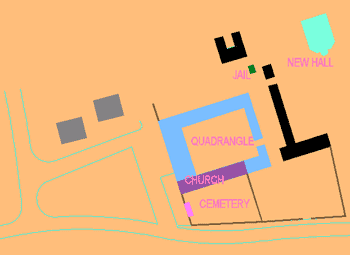
|
|
Pala Mission Road Pala, CA 92059 760-742-3317 Mailing Address: PO Box 70 Pala, CA 92059 Mission San Antonio de Pala is on the Pala Indian Reservation, off Highway 76, about 30 miles east of I-5, about 25 miles east of Mission San Luis Rey, about five miles east of I-15. About a quarter-mile after entering the reservation, a new casino sits on the south side of the highway where Pala Mission Road, the road to the mission, intersects to the north. Turn left if traveling east on Highway 76. Daily 10-4 |
 Church. Date: 10-30-11. |
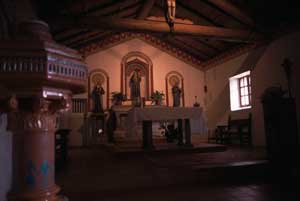 Altar and baptismal. Date: 1-24-04. |
|
San Antonio de Pala
Asistencia Main Page |
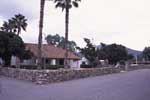 |
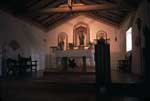 |
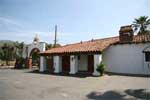 |
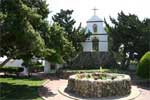 |
|
image pending |
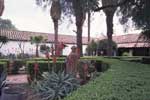 |
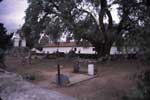 |
image pending |
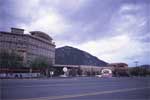 |
|
Also: The Story of Mission San Antonio de Pala by Father J. M. Carillo M.C.C.J. Pastor of Mission San Antonio de Pala, © April 1959. Available at Gift Shop. |
|
South to North
| ||

|

|

|
| Note:This is not the official site for any of the places shown in US Mission Trail. US Mission Trail is not responsible for accuracy of the information. Hours of operations, prices, and exhibits are subject to change without notice. |
|
Support this Web Site I hope that you find this web site helpful. It started because of my love for the California Missions and interest in History and a desire to share my photographs and tales of my adventures. I don't allow paid advertising. This web site is for your benefit and enjoyment and I make no profit on it. For twenty years it has been supported primarily from my regular paycheck as a Set Designer. A non-tax deductable donation helps cover the cost of operating this web site and may be made to Kesign Design Consulting through PayPal. | ||
|
If you are in the need of a designer, please see my Set Designer portfolio site Set Design Portfolio. |
| Or donations can be mailed to the address on the contact page. |
|
Links
Home |
Contact |
Sales |
Ken Larson |
K L Images |
Places Earth
|

|
This site maintained by Kenneth A. Larson. Copyright © 2004 - 2023, Kenneth A. Larson. All Rights Reserved. Website content including photographic and graphic images may not be redistributed for use on another website. |

|

|

|